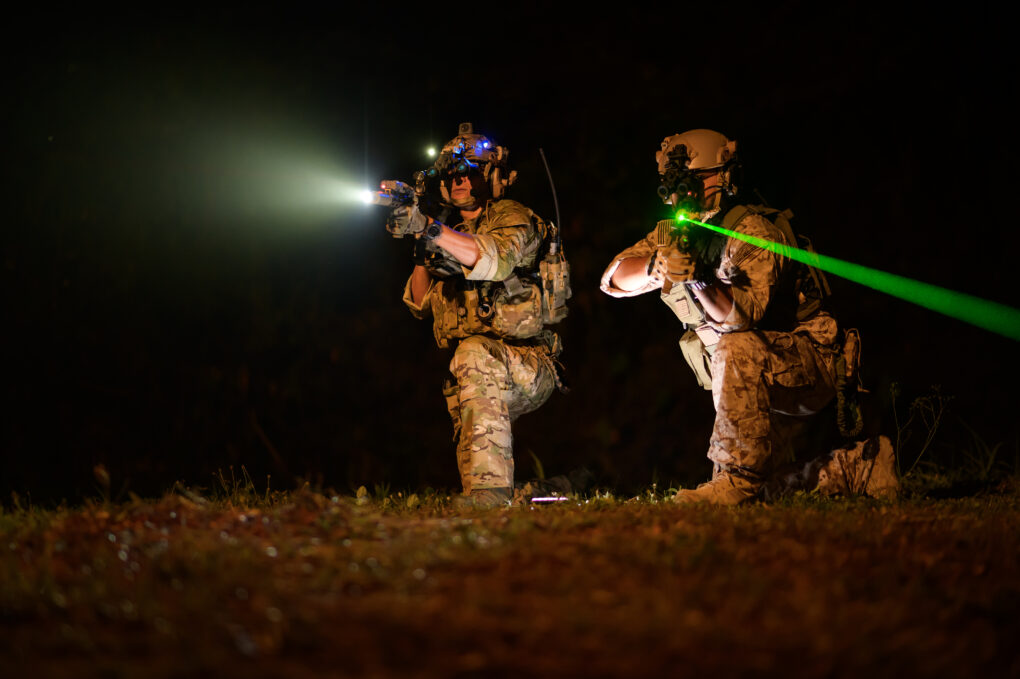Ever seen a green or IR beam cutting through the dark during night ops? That’s a tactical laser!
From civilian night shooting to elite military operations, tactical lasers have become essential for target acquisition, team coordination, and dominating low-light environments. But not all lasers are created equal, and understanding how they work can help you choose the right one for your mission.
In this guide, we’ll break down what tactical lasers do, the types available, and how to know if you’re ready for military-grade laser tech (or something more low-profile).
What is a Tactical Laser?
A tactical laser is a precision beam emitter, usually visible (green or red) or infrared (IR), mounted to a firearm to assist in aiming, target marking, or communication in low-light or no-light scenarios.
They’re widely used by:
- Law enforcement and SWAT teams
- Military special operations
- Night hunters and trainers
- K9 handlers, breachers, and recce teams
The key? Tactical lasers provide speed and certainty when lining up a shot or signaling teammates. No fumbling with iron sights or optics; just point, press, engage!
How Tactical Lasers Work
Tactical lasers project a focused beam of light (either visible or infrared) using diodes and lens systems to create long-range pinpoint targeting.
Here’s a quick breakdown:
- Visible Lasers (Red/Green): Easy to spot and track visually. Green is more visible in daylight, red is a lower profile but can bloom less in fog or smoke.
- Infrared (IR) Lasers: Invisible to the naked eye but crystal clear through NVGs. Ideal for stealthy ops and team coordination under nods.
- Combined Units: Many tactical lasers pair IR and visible beams, plus IR illuminators, giving you multi-mode options depending on lighting and gear.
Bonus: Most military-grade lasers come with activation pads or remote switches for quick engagement.
Low Power vs. High Power Tactical Lasers
When choosing a tactical laser, power level matters a lot. It affects visibility, range, and legality.
Low Power Lasers (Civilian / Law Enforcement Use)
These are regulated to meet safety standards and avoid eye hazards.
Best For:
- Law enforcement patrols
- Civilian training or night shooting
- Indoor training/shoot house use
- K9 handlers or team leaders running visible IR markers
Why We Use It: We mount a low-power IR laser on my training rifle, clean beam, low signature, perfect for team movement drills with nods.
Pro tip: A low-power laser is more than enough for 90% of tactical applications, especially under NVGs.
High Power Lasers (Military Grade / Restricted)
These are built for maximum output. They require training and restricted access but deliver insane clarity and long-range control.
Best For:
- Military operations
- Rural long-range patrols
- Aerial coordination / JTAC use
- High-threat engagements where power and range matter
Why It Matters: We’ve used high-power IR lasers in open-field ops where low-output units just didn’t cut it (especially under poor starlight or extreme fog). These lasers punch through the dark like a saber.
Warning: These are not toys. High-power tactical lasers can cause eye injury and are strictly controlled. Steele Industries vets all buyers to ensure proper use.
Use Cases in the Field
Team Coordination
Imagine a special operations team clearing a building at night. Using IR lasers visible only through night vision goggles (NVGs), the point man silently designates the next room for entry. A quick flick of the laser paints the doorway, signaling to the following team members without any audible communication, crucial in maintaining stealth and surprise.
Target Designation
Picture a law enforcement sniper positioned on a rooftop, observing a potential suspect in a crowded area. The sniper uses a precise visible laser to pinpoint the suspect, allowing other officers to quickly identify and track the individual without creating a public spectacle or alerting the suspect to their presence.
Non-Lethal Presence
Consider a border patrol unit encountering a group of undocumented individuals. To de-escalate the situation and avoid unnecessary escalation, an officer projects a bright green laser onto the ground in front of the group. This clear visual cue can often be more effective than shouting, helping to control the situation and guide the individuals toward a safe area.
Military Operations
During a long-range desert patrol, a unit needs to mark a specific grid coordinate for an air strike. Using a high-power IR laser, they illuminate the target area, providing clear guidance to the aircraft overhead. This ensures the target is accurately identified and engaged, even in challenging terrain and low-visibility conditions.
Search and Rescue
In a nighttime search operation, rescue teams equipped with NVGs and IR lasers can sweep large areas more effectively. The laser can be used to mark found individuals or key locations, enabling quick coordination and preventing the team from missing crucial details in the dark.
These examples illustrate how tactical lasers are invaluable tools in a variety of real-world situations, enhancing communication, accuracy, and safety in the field.
Military Grade Laser Systems: What to Know
Want to step into military-grade laser territory? Here’s what to expect:
- Integrated Illuminators: IR laser + IR flood light in one unit
- Multiple Modes: Visible, IR, momentary, constant-on
- Remote Switches: Mount to foregrip or rail for fast activation
- Reinforced Housing: Built to withstand drops, water, and hard use
- Export / ITAR Restrictions: Must be purchased through vetted channels
If you’re not sure whether you qualify for high-power units, our team at Steele Industries can walk you through the process.
Final Thoughts: Should You Run a Tactical Laser?
If you’re working under NVGs, coordinating with a team, or just want faster, cleaner target acquisition in the dark, a tactical laser isn’t just a nice-to-have, it’s a force multiplier.
Here’s what I recommend:
- Start with a low-power IR/visible combo if you’re training or patrolling locally
- Upgrade to high-power restricted lasers only if your mission truly demands it
- Always buy from trusted sources like Steele Industries, because a bad beam can cost you your edge
Need help choosing a unit? Whether you’re setting up your first rifle or dialing in your tenth, our experts will help match the laser to your optic, helmet, and role. Contact us today!
Tactical Lasers FAQs
Are tactical lasers legal to own?
Yes, low-power lasers are legal for civilians and law enforcement. High-power lasers are restricted and require credentials. Steele Industries handles compliance and approval during purchase.
What’s the difference between a tactical laser and a laser pointer?
Tactical lasers are weapon-mountable, highly durable, and come in IR or visible spectrum, built for real-world use. Laser pointers are consumer-grade and not field-suitable.
Can I see IR lasers with my eyes?
No, you’ll need night vision goggles to see infrared lasers. That’s why they’re preferred for stealthy ops and silent coordination.
Do I need a tactical laser if I already have night vision?
It depends. NVGs let you see, but a laser lets you aim quickly and share intent with teammates. For most night ops, NV without a laser is like running a rifle without a sling.


